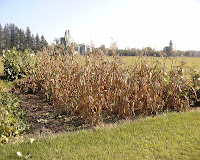 Yes, this post is about King Corn, but no it is not about the documentary that I have discussed so much lately title, “King Corn“. Todays post happens to be about chapter eight in Gene Logsdon’s book, “The Contrary Farmer.” That chapter just happens to be called “King Corn” … are you throughly confused yet? Well, this was actually probably one of my favorite chapters in the book yet … and, Mr. Logsdon is talking about corn being king because it is a good thing! I should note, that this is a chapter that my dad would really resonate with. Since we have brought the cows to the farm he has mentioned a few times that it just seems unnatural to not be feeding them any grain … almost un-American.
Yes, this post is about King Corn, but no it is not about the documentary that I have discussed so much lately title, “King Corn“. Todays post happens to be about chapter eight in Gene Logsdon’s book, “The Contrary Farmer.” That chapter just happens to be called “King Corn” … are you throughly confused yet? Well, this was actually probably one of my favorite chapters in the book yet … and, Mr. Logsdon is talking about corn being king because it is a good thing! I should note, that this is a chapter that my dad would really resonate with. Since we have brought the cows to the farm he has mentioned a few times that it just seems unnatural to not be feeding them any grain … almost un-American.
Well, Mr. Logsdon actually speaks highly of corn in this rather informational and practical chapter. I don’t know where he lands on the idea of large-scale grain farming, but for the “cottage” farmer he loves the idea of having a small (1-5 acres) plot of corn. He loves the corn because it is reliable and in his own woods, “even a fool can grow it.” Corn also has earned a place on his farm because it can easily be harvested by hand (no need for big machinery) when it is done in small amounts. But, his love of corn for the farm is best summed up by these words from the chapter,
“If nature, in her contrariness, dries up the pasture grass, I will feed corn. If she hurls hail on the corn, I will feed oats. If she blows down the oats, I will feed wheat. If she floods out the wheat, the grass will be lush.”
Basically, he sees corn as a piece of the bigger picture on his diverse farm where everything needs to earn is keep whether through monetary value or plain aesthetics.
As I mentioned just a moment ago this is one of the more practical chapters in the book. Mr. Logsdon talks about how he prepares the land for corn, plants it, cares for it, and harvests it. In each of those little sections of they chapter I learned interesting little tidbits about how he still has a place for the mold board plow, how open pollinated corn can be used, how to harvest by hand, and so much more.
I must admit that after reading this chapter I’m thinking a little more about the place corn could have on a farm that we have. I’m not so sure that I will go so far as to say that I’m ready to feed it to my cattle, but on a small-scale it could be something useful for any hogs or chickens that we had on the farm … and we plan on having both. Plus, I must admit the open invitation to use a plow (with a proper field rotation of course) and the opportunity to hand husk corn is almost a little to enticing to pass up.
I’m going to look into some open pollinated corn for this springs planting season. I know that I could get my dad to plow up some ground and put some corn in. I bet I could even get him to cultivate it if I let him drive his prairie gold tractor! But, more importantly I would like to experiment with it a little bit. Hey, if we could get any that would just be that much less that we needed to buy to feed the chickens.
I’ll let you know when the corn picking party is!
**Greenfield Farms is a place that sells open pollinated corn if you are interested in ordering online … Reid’s Yellow Dent is what Mr. Logsdon mentioned … I’m going to check around my area**


Logsdon is very much a proponent, like Wendell Berry, of a small scale diversified farm. Neither are rooted in the past, but they recall the past in looking back towards a smaller scale, diversified, farm. Particularly in the Berry’s view, the ideal farm is more of an agrarian, rather than production agriculture, farm. That isn’t to say that such farms lack a product for market, but that such farms do not focus on any one thing, and they consume their own produce in varying degrees.
Up until after WWII this would describe most American farms, although some types of farming, such as grain farming, were less agrarian than others.